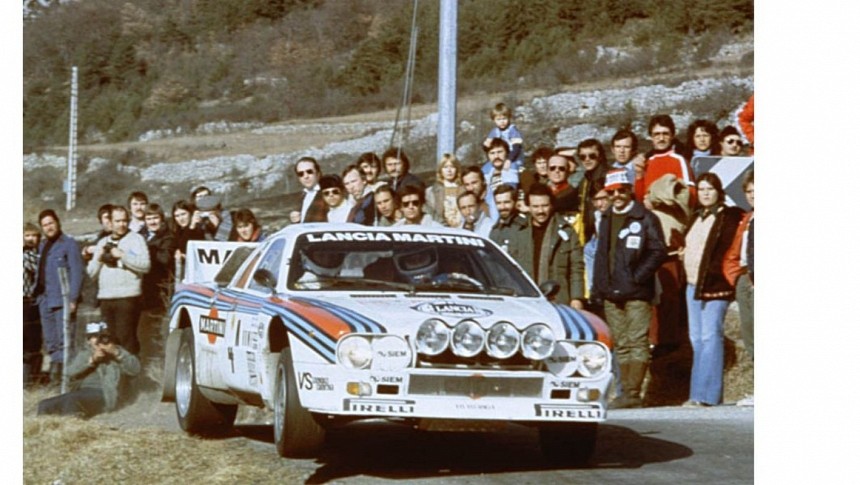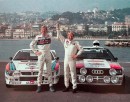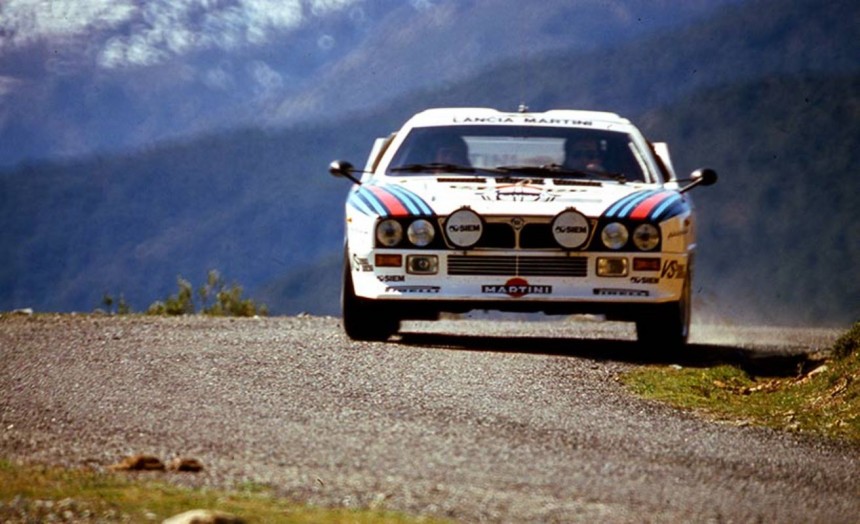Audi was anticipated to be a force of nature amidst Monte Carlo's customary wintry conditions at the 1983 World Rally Championship's curtain raiser.
However, the weather decided to play the devil's advocate, presenting unseasonably warm temperatures, coupled with Lancia's outside-the-box strategy, so the scales tipped dramatically. Reflecting on this unexpected plot twist four decades later, team manager Cesare Fiorio fondly remembers the audacious astounding triumph in the Monte Carlo Rally, which kickstarted the 1983 World Rally Championship season, by unseating the seemingly invincible four-wheel-drive Audi Quattro, etching itself into the annals of rallying lore and earning its place among the legendary motorsport underdog tales.
This victory ignited a ferocious yet enthralling face-off with Audi, which eventually crowned the gutsy Italian brand as the champion. Lancia's rear-wheel-drive 037 beast holds the record as the final two-wheel-drive car to clinch the manufacturer's title. As 1983 dawned, the aftermath of a regulation modification implemented four years earlier, sanctioning four-wheel-drive vehicles in the Group B WRC, was palpably evident.
The rallying cosmos was reeling, leaving Opel, Toyota, Nissan, and Lancia stunned in the wake of Audi's new menacing powerhouse Audi's duo. Hannu Mikkola and Michele Mouton had racked up a quintet of victories in 1982, securing the prestigious manufacturers' title for the Ingolstadt-based outfit, while Opel's Walter Rohrl narrowly outpaced Mouton for the drivers' crown.
Lancia's countermove was the conception of the lightweight (975kg-2,149.5 lbs), mid-engined, rear-wheel-drive 037 – an absolute game-changer. A streamlined body draped over a tubular chassis, powered by a supercharged four-cylinder engine churning out slightly north of 304 hp (308 PS), promised to be a tarmac terror, albeit potentially outgunned by the Audi on loose terrains.
The 037 had its inaugural run towards the end of 1982, rather inconspicuously, but the revamped version that made its entrance in 1983 was a horse of a different color. Yet, as Monte Carlo approached with forecasts predicting ice and snow, Audi seemed poised for a walkover victory.
Lancia could also boast of a formidable line-up of drivers. The reigning champion, Rohrl, had been enticed away from Opel to join Lancia's star player, Markku Alen. However, Rohrl had no intentions of defending his title and chose to participate only in selected events that piqued his interest.
Lancia's hopes for Monte Carlo were buoyed by uncharacteristically warm weather, reducing the usual blankets of snow and ice to mere patches on the renowned Alpine tarmac stretches. Further tipping the scales in their favor, Lancia took a hands-on approach under the ingenious leadership of their charismatic commander, Fiorio – with a little help from some salt. This wouldn't be the last trick up Lancia's sleeve. Despite the scarcity of snow and ice, it was Audi who stole the limelight on day one.
Stig Blomqvist established a 10s lead over Opel’s Guy Frequelin, while Rohrl trailed by another six seconds in the leading 037. Lancia would retaliate on day two, showcasing the formidable prowess of the 037 on the dry tarmac for all to witness. The Quattros of Blomqvist, Mikkola, and Mouton were no match for the nimble 037s that devoured the winding routes. Rohrl seized nine out of the day's 14 stages as Lancia shocked Audi with its blistering speed. The Martini-clad 037s occupied the top two spots, with Alen 3m26s behind Rohrl, while Blomqvist, driving the nearest Audi, was a staggering 8m22s off the pace in third place.
While the conditions did favor Lancia, another intelligent strategy played its part in giving them the upper hand. No existing regulations prohibited crews from swapping all four wheels during a live stage, giving birth to the concept of in-stage pitstops. The advantage of navigating the dry portions of the stages on slicks and switching to studded snow tires before the icy segments saved them an impressive two minutes.
In subsequent events, competing teams quickly adopted the in-stage pitstop strategy before the FIA eventually outlawed the practice in 1986. In the meantime, Rohrl and Alen, driving the Lancias, were untouchable, and they clinched a resounding one-two finish. The third factory, 037, helmed by French virtuoso Jean-Claude Andruet, finished eighth following a supercharger malfunction on day two. Colossal triumph was complete, winning 20 out of the 31 stages. Blomqvist, representing the stunned Audi squad, could do no better than third place, trailing by 11m18s.
Indeed, this marked the genesis of a spirited tussle with Audi that culminated in a surprise championship triumph for Lancia. Even though the Italian firm decided against participating in Sweden's snowy stages or the grueling Safari Rally – both dominated by the expected Audi supremacy – they still clinched the title two events early, thanks to a memorable one-two-three finish on home turf in Sanremo. Their victory was built on earlier wins in Corsica (Alen), the Acropolis (Rohrl), and New Zealand (Rohrl).
The epic Lancia-Audi face-off has inspired a movie due to grace cinema screens. Titled 'Win,' the film, directed by Italian Stefano Mordini, is currently undergoing post-production. Riccardo Scamarcio, known for his role as the Italian mob boss in the action thriller 'John Wick: Chapter 2', has been cast as Fiorio. Daniel Bruhl, who portrayed Niki Lauda in the Formula 1 film 'Rush,' will step into the shoes of Audi chief Roland Gumpert. German actor Volker Bruch has been tasked with bringing Rohrl to life on screen. Hanway Films, based in London, is managing the global sale of the film, which is yet to announce a release date.
This victory ignited a ferocious yet enthralling face-off with Audi, which eventually crowned the gutsy Italian brand as the champion. Lancia's rear-wheel-drive 037 beast holds the record as the final two-wheel-drive car to clinch the manufacturer's title. As 1983 dawned, the aftermath of a regulation modification implemented four years earlier, sanctioning four-wheel-drive vehicles in the Group B WRC, was palpably evident.
The rallying cosmos was reeling, leaving Opel, Toyota, Nissan, and Lancia stunned in the wake of Audi's new menacing powerhouse Audi's duo. Hannu Mikkola and Michele Mouton had racked up a quintet of victories in 1982, securing the prestigious manufacturers' title for the Ingolstadt-based outfit, while Opel's Walter Rohrl narrowly outpaced Mouton for the drivers' crown.
Lancia's countermove was the conception of the lightweight (975kg-2,149.5 lbs), mid-engined, rear-wheel-drive 037 – an absolute game-changer. A streamlined body draped over a tubular chassis, powered by a supercharged four-cylinder engine churning out slightly north of 304 hp (308 PS), promised to be a tarmac terror, albeit potentially outgunned by the Audi on loose terrains.
The 037 had its inaugural run towards the end of 1982, rather inconspicuously, but the revamped version that made its entrance in 1983 was a horse of a different color. Yet, as Monte Carlo approached with forecasts predicting ice and snow, Audi seemed poised for a walkover victory.
Lancia's hopes for Monte Carlo were buoyed by uncharacteristically warm weather, reducing the usual blankets of snow and ice to mere patches on the renowned Alpine tarmac stretches. Further tipping the scales in their favor, Lancia took a hands-on approach under the ingenious leadership of their charismatic commander, Fiorio – with a little help from some salt. This wouldn't be the last trick up Lancia's sleeve. Despite the scarcity of snow and ice, it was Audi who stole the limelight on day one.
Stig Blomqvist established a 10s lead over Opel’s Guy Frequelin, while Rohrl trailed by another six seconds in the leading 037. Lancia would retaliate on day two, showcasing the formidable prowess of the 037 on the dry tarmac for all to witness. The Quattros of Blomqvist, Mikkola, and Mouton were no match for the nimble 037s that devoured the winding routes. Rohrl seized nine out of the day's 14 stages as Lancia shocked Audi with its blistering speed. The Martini-clad 037s occupied the top two spots, with Alen 3m26s behind Rohrl, while Blomqvist, driving the nearest Audi, was a staggering 8m22s off the pace in third place.
While the conditions did favor Lancia, another intelligent strategy played its part in giving them the upper hand. No existing regulations prohibited crews from swapping all four wheels during a live stage, giving birth to the concept of in-stage pitstops. The advantage of navigating the dry portions of the stages on slicks and switching to studded snow tires before the icy segments saved them an impressive two minutes.
Indeed, this marked the genesis of a spirited tussle with Audi that culminated in a surprise championship triumph for Lancia. Even though the Italian firm decided against participating in Sweden's snowy stages or the grueling Safari Rally – both dominated by the expected Audi supremacy – they still clinched the title two events early, thanks to a memorable one-two-three finish on home turf in Sanremo. Their victory was built on earlier wins in Corsica (Alen), the Acropolis (Rohrl), and New Zealand (Rohrl).
The epic Lancia-Audi face-off has inspired a movie due to grace cinema screens. Titled 'Win,' the film, directed by Italian Stefano Mordini, is currently undergoing post-production. Riccardo Scamarcio, known for his role as the Italian mob boss in the action thriller 'John Wick: Chapter 2', has been cast as Fiorio. Daniel Bruhl, who portrayed Niki Lauda in the Formula 1 film 'Rush,' will step into the shoes of Audi chief Roland Gumpert. German actor Volker Bruch has been tasked with bringing Rohrl to life on screen. Hanway Films, based in London, is managing the global sale of the film, which is yet to announce a release date.














